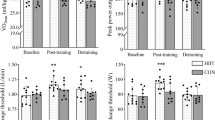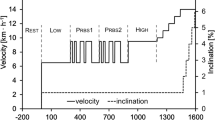Summary
Maximal aerobic (\(\dot V_{{\text{O}}_{\text{2}} }^{\max }\)) and anaerobic power (\(\dot W_{\text{P}}^{\max }\)), fat free body weight, maximal cardiac output (\(\dot Q_{}^{\max }\)) stroke volume (q max) of the heart and the O2 capacity of the blood (Hb) were measured on 145 subjects in the age range 9–64 selected at random on a population of a subalpine area of Northern Italy. At the age of 17–25 years (\(\dot V_{{\text{O}}_{\text{2}} }^{\max }\)) has been found to be on the average 41.5 ml/kg · min in the males and 33.9 ml/kg · min in the females: when referred to 1 kg of lean body weight (\(\dot V_{{\text{O}}_{\text{2}} {\text{LBW}}}^{\max }\)), it amounts to 48 and 46 ml O2/kg · min respectively. (\(\dot W_{\text{P}}^{\max }\)) expressed as ml O2/kg · min in the same group of individuals is 173 for males and 146 for females. When referred to 1 kg of lean body weight the maximal anaerobic power is respectively 201 and 199 ml O2/kg · min. Both (\(\dot V_{{\text{O}}_{\text{2}} }^{\max }\)) and (\(\dot W_{\text{P}}^{\max }\)) decrease with increasing age.
(\(\dot Q_{}^{\max }\)) appears to be a linear function of\(\dot V_{{\text{O}}_{\text{2}} }^{\max }\) ·q is on the average 1.6 ml per kilogram of body weight for males with a high individual variability (σ = 15%) and 1.4 for females: it appears to be independent of age.
Similar content being viewed by others
References
Aghemo, P., Rovelli, E., Piñera Limas, F., Cerretelli, P.: La Massima Potenza Musoolare Anaerobica (alattioa) in Funzione dell'età e del sesso. Medicina dello Sport21, 495–497 (1968).
Andersen, K. L.: Ethnic group differences in fitness for sustained and strenous muscular exercise. Proc.: Inter. Symp. on Physical Activity and Cardiovascular Health, pp. 832–833 (1966).
Andersen, K. L., Elsner, B. W., Saltin, B., Hermansen, L.: Physical fitness in terms of maximal oxygen intake of nomadic Lapps. Abstract XXII, Inter. Cong. Physiol. Sci. Leiden, p. 739 (1962).
Åstrand, I.: Aerobic work capacity in men and women. Acta physiol. scand.49, Suppl. 169 (1960).
Åstrand, P. O.: Experimental studies of physical working capacity in relation to sex and age. Copenhagen: Munksgaard 1952.
Bassi, P.: La massima potenza muscolare aerobica ed anaerobica di individui appartenenti a gruppi etnici diversi. Tesi di specializzazione di Medicina dello Sport, Università di Milano, 1968.
Cerretelli, P., Aghemo, P., Rovelli, E.: Aspetti fisiologici dell'adolescente in relazione alla pratica dell'esercizio fisico. Medicina dello Sport21, 400–406 (1968).
—, Radovani, P.: Il massimo consumo di O2 in atleti olimpionici di varie specialità. Boll. Soc. ital. Biol. sper.36, 1871–1872 (1960).
Di Prampero, P.E.: Personal communication: University of Milan, Milan, Italy, June 1970.
—, Cerretelli, P.: Maximal muscular power (aerobic and anaerobic) in African natives. Ergonomics12, 51–59 (1969).
—: Piñera Limas, F., Sassi, G.: Maximal muscular power (aerobic and anaerobic) in 116 athletes performing at the XIXth Olympic Games in Mexico. Ergonomics13, 665–674 (1970).
Durnin, J. V. G. A., Rahaman, M. M.: The assessment of the amount of fat in human body from measurements of skinfold thickness. Brit. J. Nutr.21, 681 (1967).
Hermansen, L.: Aerob arbeids kapasiteti relasjon til older og kønn. Can. Real. Thesis, University of Oslo, 1964.
Margaria, R.: Energy production of muscular work in the aged. 7th Inter. Congress of Gerontology Proceedings, Vienna, pp. 71–78, 1966.
—, Aghemo, P., Rovelli, E.: Indirect determination of maximal O2 consumption in man. J. appl. Physiol.20, 1070–1073 (1965).
— — —: Measurement of muscular power (anaerobic) in man. J. appl. Physiol.21, 1662–1664 (1966).
—, Cerretelli, P., Aghemo, P., Sassi, G.: Energy cost of running. J. appl. Physiol.18, 367–371 (1963).
— —, Veicsteinas, A.: The prediction of the stroke volume of the heart from the heart rate at submaximal exercise. J. appl. Physiol.29, 204–207 (1970).
Rennie, D. W., Fitts, R. W., di Prampero, P.: Physical fitness (maximal aerobic and anaerobic power) and respiratory function of Alaskan Eskimos. Report to Inter. Biol. Program. Human Adaptability Sect.
Robinson, S.: Experimental studies of physical fitness in relation to age. Arbeitsphysiologie10, 251–323 (1938).
Van Kampene, E. J., Zijlstra, W. G.: Standardization of Hemoglobinometry II. The hemoglobincyanide method. Clin. chim. Acta6, 538–544 (1961).
Wyndham, C.H., Strydom, N. B., Morrison, J. F., Williams, C. G., Bredell, G. A., Heyns, H.: The capacity for endurance effort of Bantu males from different tribes. S. Afr. J. clin. Sci.62, 259–263 (1966).
Author information
Authors and Affiliations
Additional information
This work was supported by a grant from the Italian National Research Council (C.N.R.), Section I.B.P.
On leave from the Department of Biology, Texas Woman's University, Denton, Texas, U.S.A.
Rights and permissions
About this article
Cite this article
Steplock, D.A., Veicsteinas, A. & Mariani, M. Maximal aerobic and anaerobic power and stroke volume of the heart in a subalpine population. Int. Z. Angew. Physiol. Einschl. Arbeitsphysiol. 29, 203–214 (1971). https://doi.org/10.1007/BF01100532
Received:
Issue Date:
DOI: https://doi.org/10.1007/BF01100532




